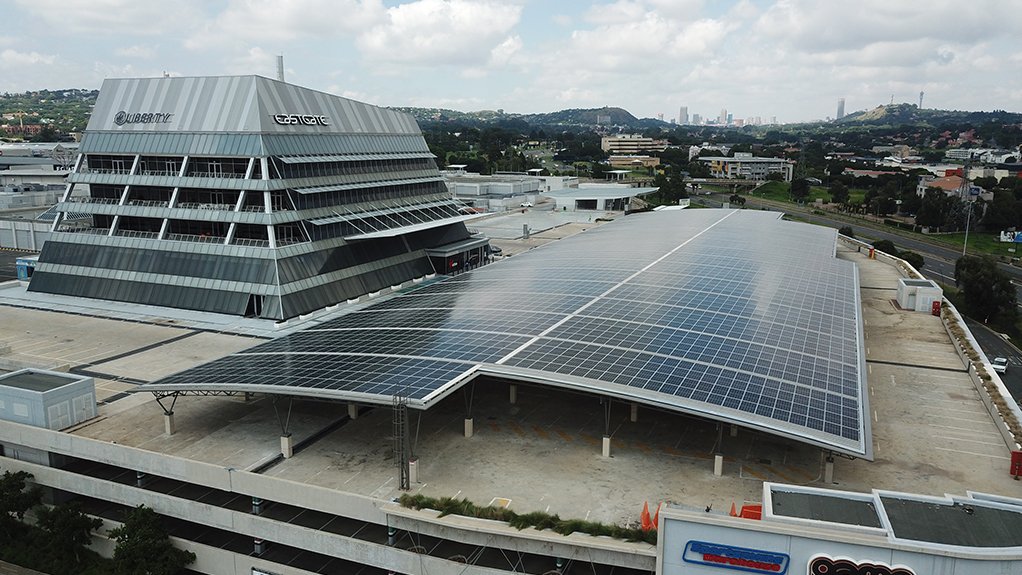While loadshedding is driving the uptake of embedded electricity solutions, it is also deemed obstructive by renewable-energy solutions company Solareff, owing to the financial implications for clients seeking to invest in large, industrial rooftop or ground-mounted solar photovoltaic (PV) systems.
“We need our clients to be in a financially sound position and loadshedding has a negative effect on most clients’ finances. However, demand is substantial in light of the continued intermittent power supply and the high cost of electricity, as companies are now realising that embedded solar generation is the most cost-effective option,” Solareff CEO Jaco Botha tells Engineering News.
He says solar has gone from being the most expensive power solution to the “cheapest option by far”, with the cost reducing substantially over the past 15 years as the technology has become more mainstream and economies of scale have set in. However, as South Africa continues to battle electricity supply constraints, the law of supply and demand has driven up the price of solar solutions.
Nonetheless, Botha says there is a “healthy mix” of self-funded and financed projects locally, with projects financed either through banks or solutions providers such as Solareff.
The bulk of the company’s business comprises return clients, which continue to add capacity to their existing systems.
Solareff clients are “going as big as practically possible” in light of the licensing threshold under Schedule 2 of the Electricity Regulation Act, No 4 of 2006, being lifted from 1 MW to 100 MW last year, notes Botha. This licensing threshold will soon be removed in its entirety, as announced by President Cyril Ramaphosa earlier this year.
“Embedded generation is the solution to the electricity supply challenges South Africa faces, but there is also significant uptake of battery energy storage systems (BESSs) to either limit risk through energy security (back-up power systems) or to reduce costs through the benefits derived from energy arbitrage.”
This cost-saving technique traditionally involves buying power during off-peak times when electricity is cheapest, storing it using a BESS and discharging it during peak times, when the cost of electricity is highest, to reduce electricity expenses.
There is also considerable interest in the wheeling of privately generated power through the grid between private generators and consumers, but it is still “early days”, says Botha.
“The regulators, State-owned power utility Eskom and municipal power utilities, are still wrapping their heads around the topic and getting the right rules and systems in place.”
Besides improving local electricity supply, the installation of distributed generators in various areas across the country will also reduce pressure on the distribution and transmission system because the same amount of power no longer needs to be transmitted over long distances from a central point – a power station – as power will be generated closer to where it is actually consumed.
Powerful Projects
Solareff’s completed and in-progress projects exceed 160 MWp in capacity and the company is experiencing a massive demand for its services, with interest in embedded generation solutions across all sectors of the economy, from mining companies and agriculture to real estate investment trusts, says Botha.
Projects completed by Solareff include a 1 219 kWp grid-tied solar PV parkade solution with generator integration at the Eastgate Shopping Mall, in Germiston, Gauteng.
Completed in January last year, the project will yield a significant electricity saving for the shopping centre through the generation of 1 850 000 kWh/y; the project also provides shaded parking for shoppers.
This is in addition to installing a 669.7 kWp grid-tied solar PV rooftop solution at the Tembi Mall in Tembisa, Gauteng, and a 592 kWp grid-tied solar PV solution at wine producer Orange River Cellars, in the Northern Cape, in April last year.
Orange River Cellars, which comprises five wineries, implemented the project to not only reduce its overall operating costs but also lower its carbon footprint.
The solution will provide about 35% of the operation’s total yearly power consumption – 1 058 MWh/y – saving 1 121 t of carbon dioxide emissions.
Edited by: Zandile Mavuso
Creamer Media Senior Deputy Editor: Features
EMAIL THIS ARTICLE SAVE THIS ARTICLE
ARTICLE ENQUIRY
To subscribe email subscriptions@creamermedia.co.za or click here
To advertise email advertising@creamermedia.co.za or click here















